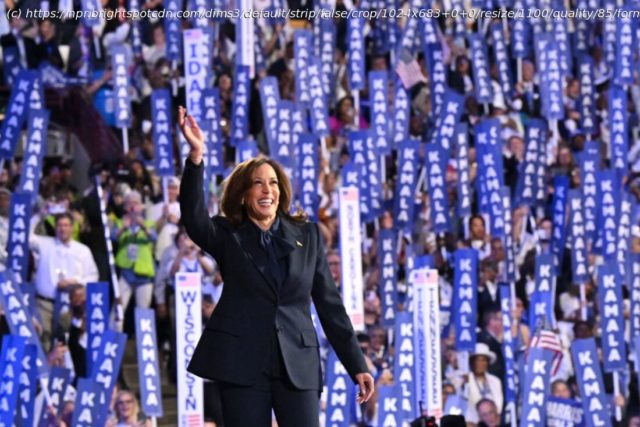They range from characterizations of former President Trump’s stances on abortion rights and Social Security to her plans to address housing and grocery prices.
There were about a dozen statements that Vice President Kamala Harris made during her roughly 40-minute acceptance speech at the Democratic National Convention in Chicago that were either misleading or lacking in context.
They range from characterizations of former President Trump’s stances on abortion rights and Social Security to her plans to address housing and grocery prices.
It’s the role of the press to try and hold politicians to account for the accuracy of their statements in a good-faith way. The dozen Harris statements lacking in context are far less in comparison to 162 misstatements, exaggerations and outright lies that NPR found from Trump’s hour-long news conference Aug. 8.
Nonetheless, here’s what we found from Harris’ convention speech:
1. “His explicit intent to jail journalists, political opponents, and anyone he sees as the enemy.”
Trump has promised retribution against his political enemies, has called reporters “the enemy of the people,” and has made vague threats of jail time for reporters.
“They’ll never find out, & it’s important that they do,” Trump wrote in a post on his social media platform after the leak of a draft of the Dobbs decision was published. “So, go to the reporter & ask him/her who it was. If not given the answer, put whoever in jail until the answer is given. You might add the editor and publisher to the list.”
He’s made other such comments, but there’s no explicit and specific policy from Trump on this because, as with many things involving Trump, he has been vague about his specific intentions.
2. “[W]e know and we know what a second Trump term would look like. It’s all laid out in Project 2025, written by his closest advisers. And its sum total is to pull our country back to the past.”
Project 2025 is the work of people with close ties to Trump through the Heritage Foundation. Trump has disavowed parts of Project 2025, and a campaign official called it a “pain in the ass.” There’s good political reason for that. Many of the detailed proposals are highly controversial and unpopular. The website for Project 2025 lays out some of the connections to the Trump administration in black and white, as well as the group’s belief that a Trump administration will use it as a blueprint:“The 2025 Presidential Transition Project is being organized by the Heritage Foundation and builds off Heritage’s longstanding ‘Mandate for Leadership,’ which has been highly influential for presidential administrations since the Reagan era. Most recently, the Trump administration relied heavily on Heritage’s “Mandate” for policy guidance, embracing nearly two-thirds of Heritage’s proposals within just one year in office.
“Paul Dans, former chief of staff at the Office of Personnel Management (OPM) during the Trump administration, serves as the director of the 2025 Presidential Transition Project. Spencer Chretien, former special assistant to the president and associate director of Presidential Personnel, serves as associate director of the project.”
In fact, CNN reported that “at least 140 people who worked in the Trump administration had a hand in Project 2025,” including his former chief of staff Mark Meadows and adviser Stephen Miller.
What’s more, CBS News found at least 270 policy proposals that intersect with the about 700 laid out in Project 2025.
3. “We’re not going back to when Donald Trump tried to cut Social Security and Medicare.”
Former President Trump has pledged not to cut Social Security, the popular retirement program. While he was in office, Trump did try, unsuccessfully, to cut benefits for people who receive disability payments from Social Security.
Social Security benefits could be cut within a decade anyway, unless Congress takes steps to shore up the program. With tens of millions of baby boomers retiring and starting to draw benefits, and fewer people in the workforce paying taxes for each retiree, Social Security is expected to run short of cash in 2033. If that happens, almost 60 million retirees and their families would automatically see their benefits cut by 21%.






